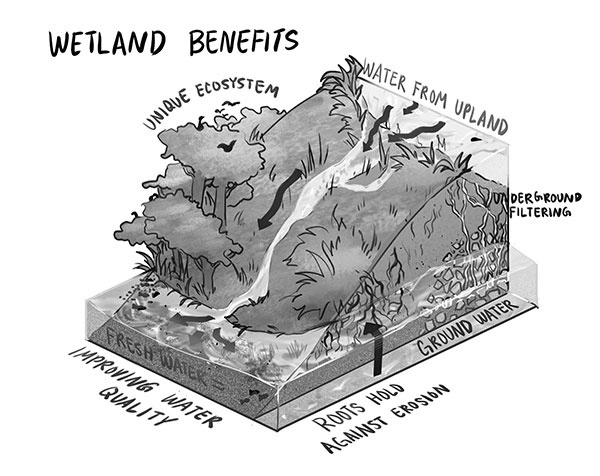Do we really need wetlands in the CNMI?
DCRM area of particular concern: Wetlands and mangroves
What are wetlands? As the name implies, a piece of land that is wet, of course. But there is a deeper explanation for that, a reasoning that can affect the way we live if we don’t take actions to protect it. Before coming in to my DCRM internship, that line of thinking was my default definition of a wetland. And while it’s not wrong, I realized that I have a lot to learn about wetlands, especially after participating in one of DCRM’s cleanup events at Jeffrey’s Beach.
Wetlands are areas of land saturated in surface or groundwater (usually submerged, depending on the season). They come in a variety of forms such as ponds, lakes, swamps, mangroves, streams, or for Jeffrey’s Beach, a coastal estuary. An estuary is where the mouth of a river meets the open water. And since water from the Talofofo watershed upland filters down into Jeffrey’s beach, this area of land is considered a brackish (where fresh and saltwater converge) or coastal wetland.
This is one of the many abilities a wetland has for the environment and one of the prime reasons to preserve its livelihood. Firstly, they can naturally filter out polluted water which is vital to human health and wildlife survival. The complex and unique vegetation that grows in a wetland cleans the polluted water of unwanted chemicals, debris, nutrients and sediments. So, for instance, when freshwater from the Talofofo watershed flows down the natural waterway or stream and into the ocean, it is filtering the polluted water at the same time.
Mammals, birds, amphibians, and certain marine life also rely on wetlands due to the multitude of plant life that this habitat can house. It is able to hold endangered species of plants and animals in their certain corners of the world such as the endangered Rota Blue Damselfly in Rota or the endangered Mariana Common Moorhen in the marshes of Saipan. These habitats not only house thousands of wildlife and keep our water quality in check just by living out their natural cycles, it also keeps us safe from flooding.
Another function of a wetland is erosion control. During the rainy season, wetlands absorb stormwater runoff into the ground by either trickling directly down for groundwater recharge or is filtered into streams, and eventually, the open ocean. Flooding would naturally accelerate waters that are already eroding away our landmass. Wetlands help mitigate the damage. It can help reinforce the land through their plant life, binding the earth together to withstand against those tides. This becomes increasingly significant especially when our region is expected to experience more frequent and intense extreme rainfall events due to global warming (*PIRCA Climate Science Summary, 2019).
The most common causes of wetland loss are impacts from developments (land clearing and backfilling) and the introduction of invasive species such as the exotic mosquito fish (Gambusia affinis) and tilapia (Sarotheradon mossambicus), (Best & Davidson, 1981). We place ourselves at risk when properties are being developed on wetlands, while those built in lower areas become more susceptible to flooding. Unchecked flooding can cause damages in revenue and towards the environment especially with improper channeling of those waters.
The loss of a wetland can be reduced or avoided if we take the necessary steps to- (1) learn more, or educate each other more, about the important functions and benefits of a wetland; (2) appreciate the services or benefits that it provides, or can provide, to communities including various species that depend on it; and (3) consider alternative measures to avoid developing a wetland. We must ensure that wetlands continue to function the way it was naturally created to function. As natural stewards of the environment, we need to start making wise and eco-friendly decisions like how to improve the quality of our groundwater source.
Although it is not our intent to stop development, we must remind ourselves that we are, first, natural stewards of our environment. We must invest in more eco-friendly alternatives or practices that will help preserve our wetlands, streams, and mangroves for future generations and our island way of life. Please help preserve the very few wetlands that we have left in the CNMI. So yes, we need healthy and functional wetlands.
—
If you are proposing a project or activity within the Wetland APC, please apply for a coastal permit at the BECQ-DCRM, Permitting Section, Gualo Rai Center, Suite 303, Middle Road, Lower Gulao Rai, or call Permitting Section at 664-8300 for more information.
Words to know:
Wetlands—The geographic area of particular concern in which the ground is saturated by surface or groundwater, it has an ability to support vegetation and maintain its own unique ecosystem. Wetlands consist of swamps, marshes, mangroves, lakes, natural ponds, surface springs, streams, estuaries, or similar areas.
*Pirca Climate Change Science Summary Update 2019, Climate Change in the Commonwealth of the Northern Mariana Islands: Indicators and Considerations for Key Sectors.
***
Cerijean F. Mangubay is a student at the Northern Marianas College and currently serves as a summer intern with the Division of Coastal Resources Management. This article is the third of a short series that discusses the significance of DCRM’s areas of particular concern (APCs) and why these resources are subject to special management standards.




























